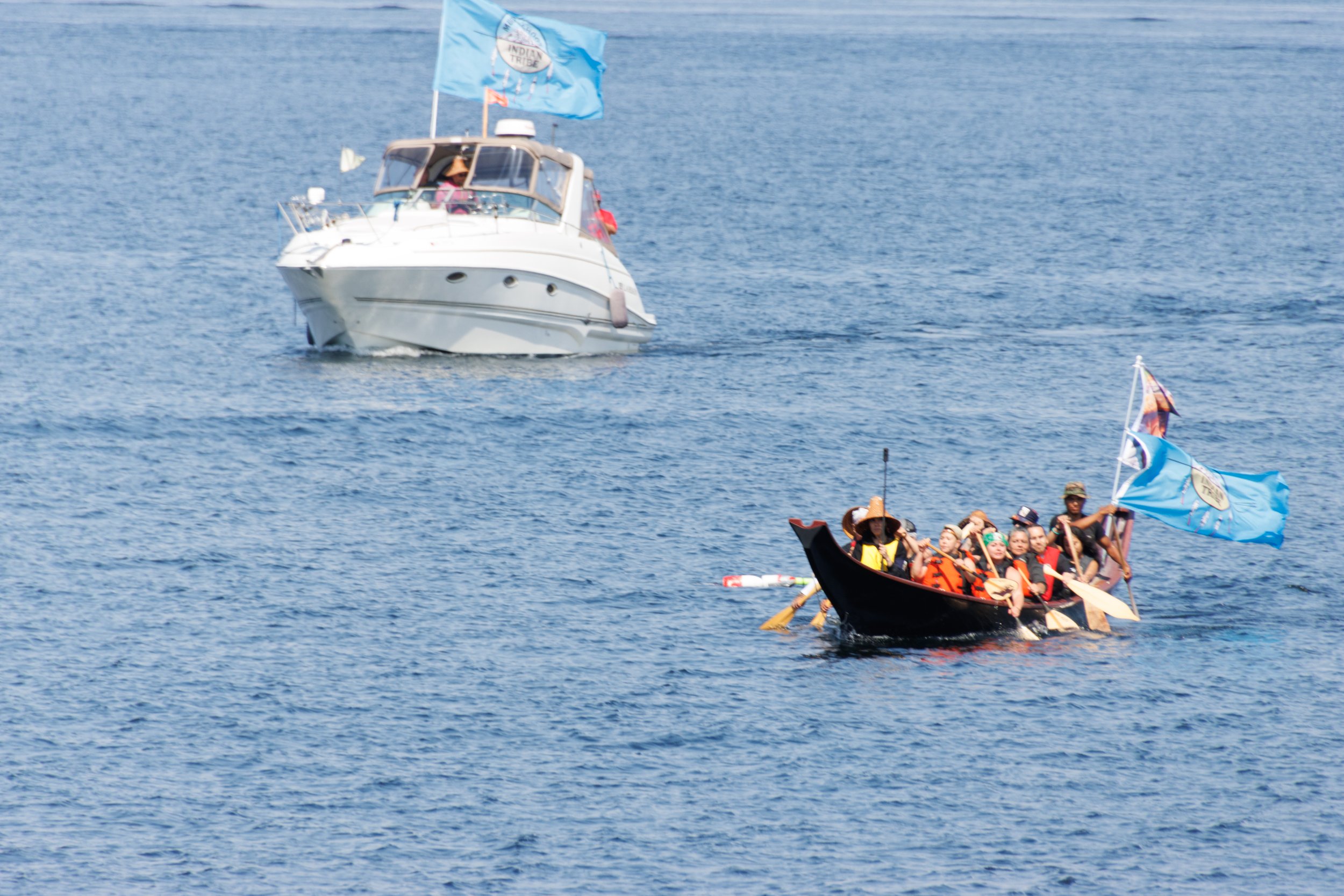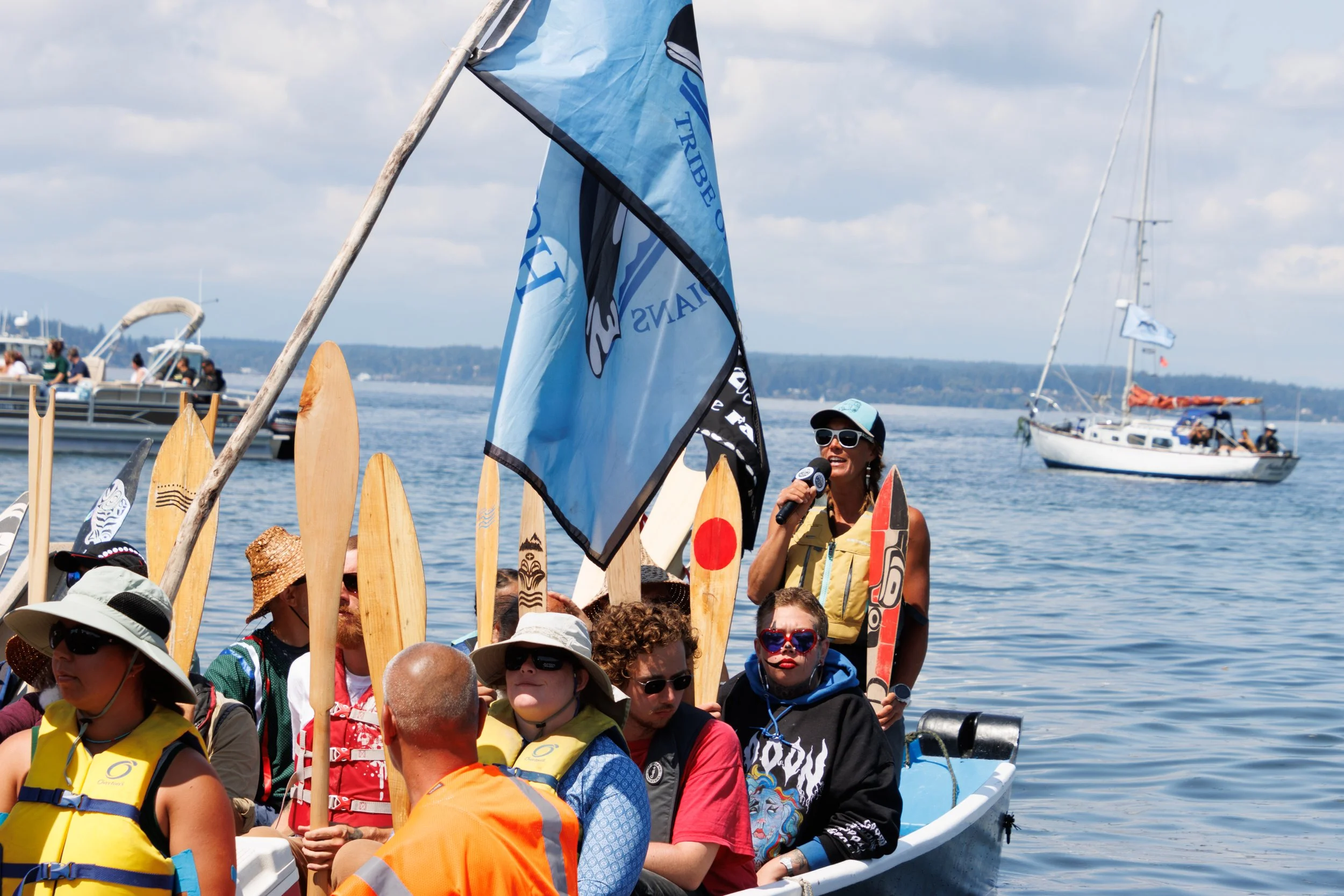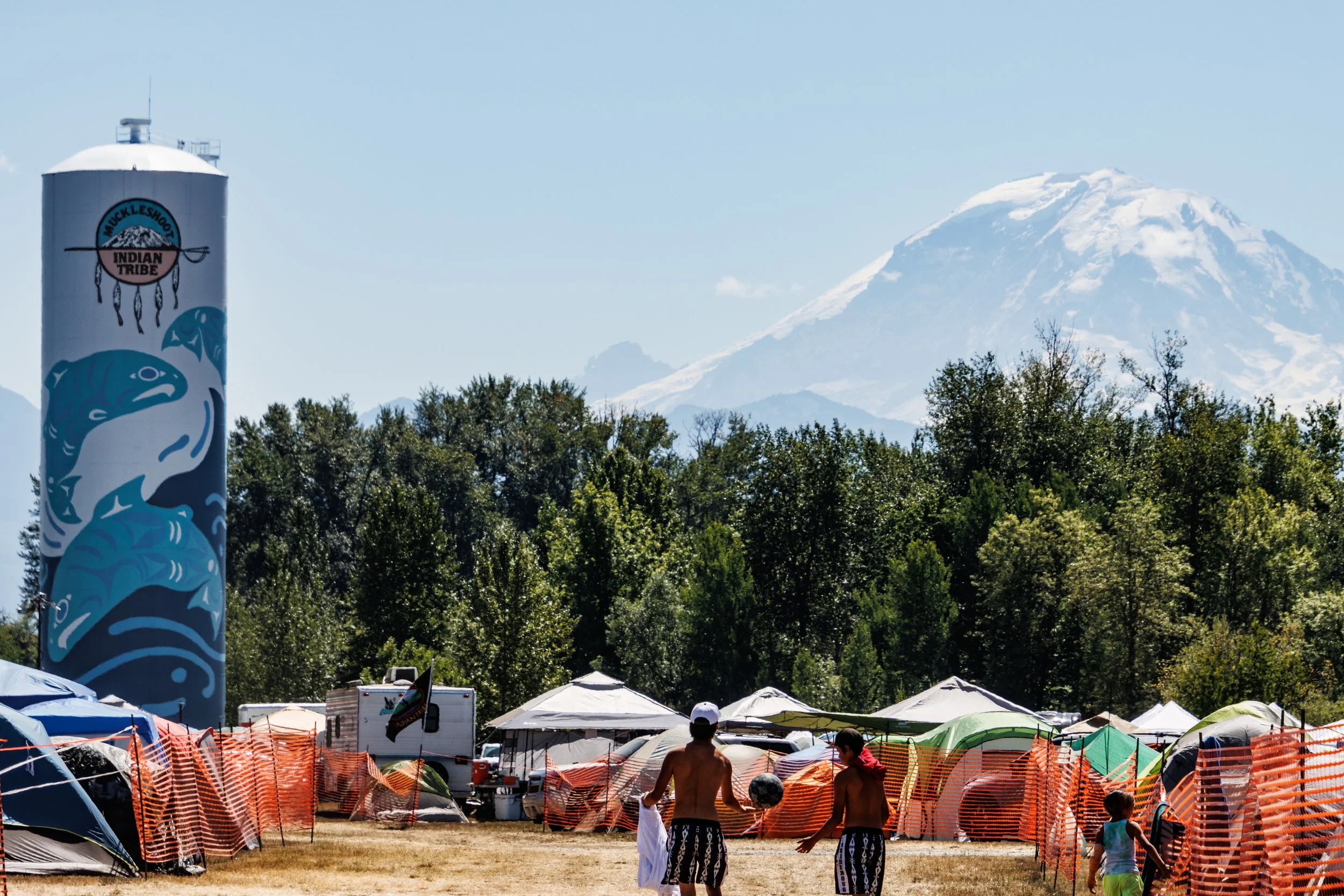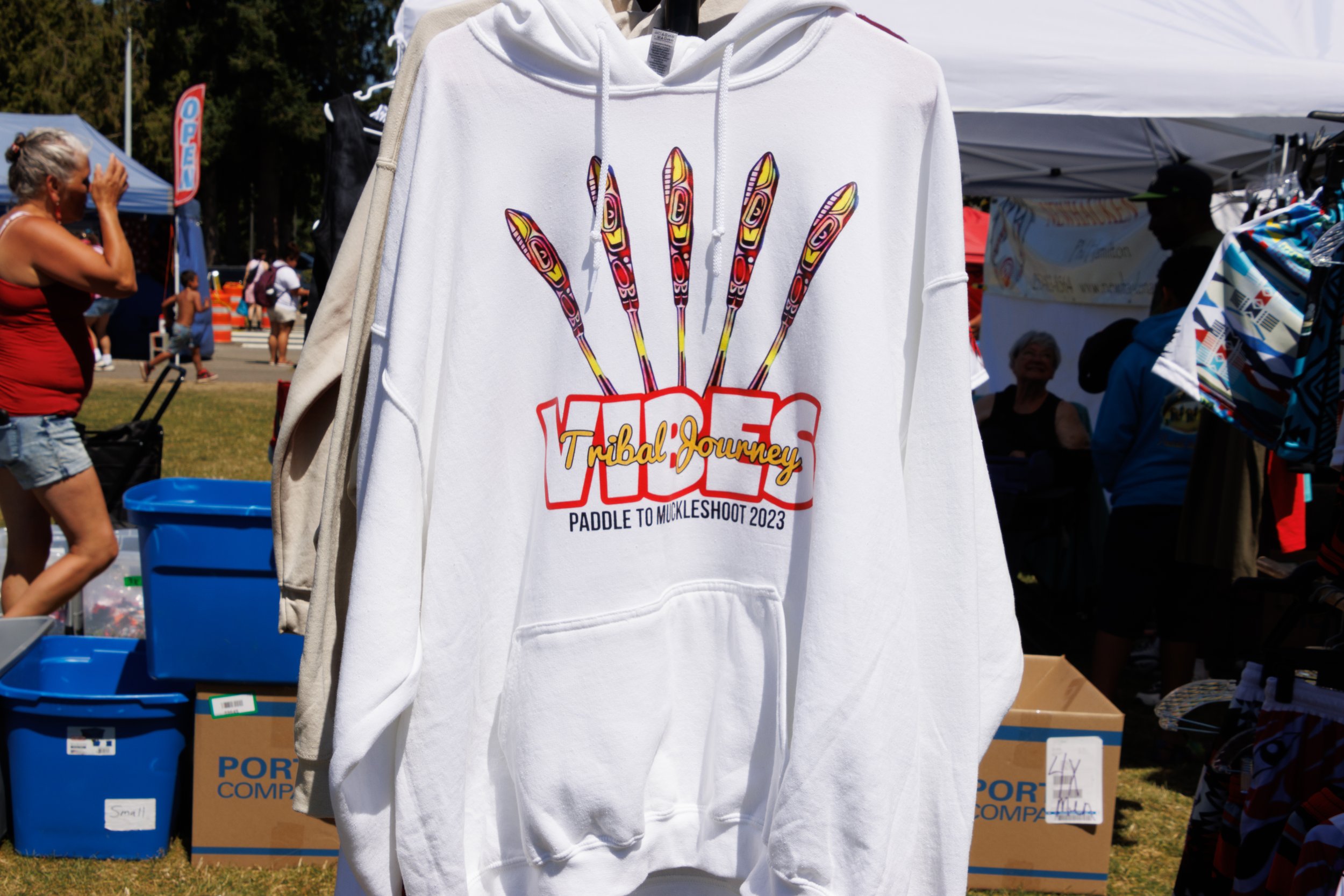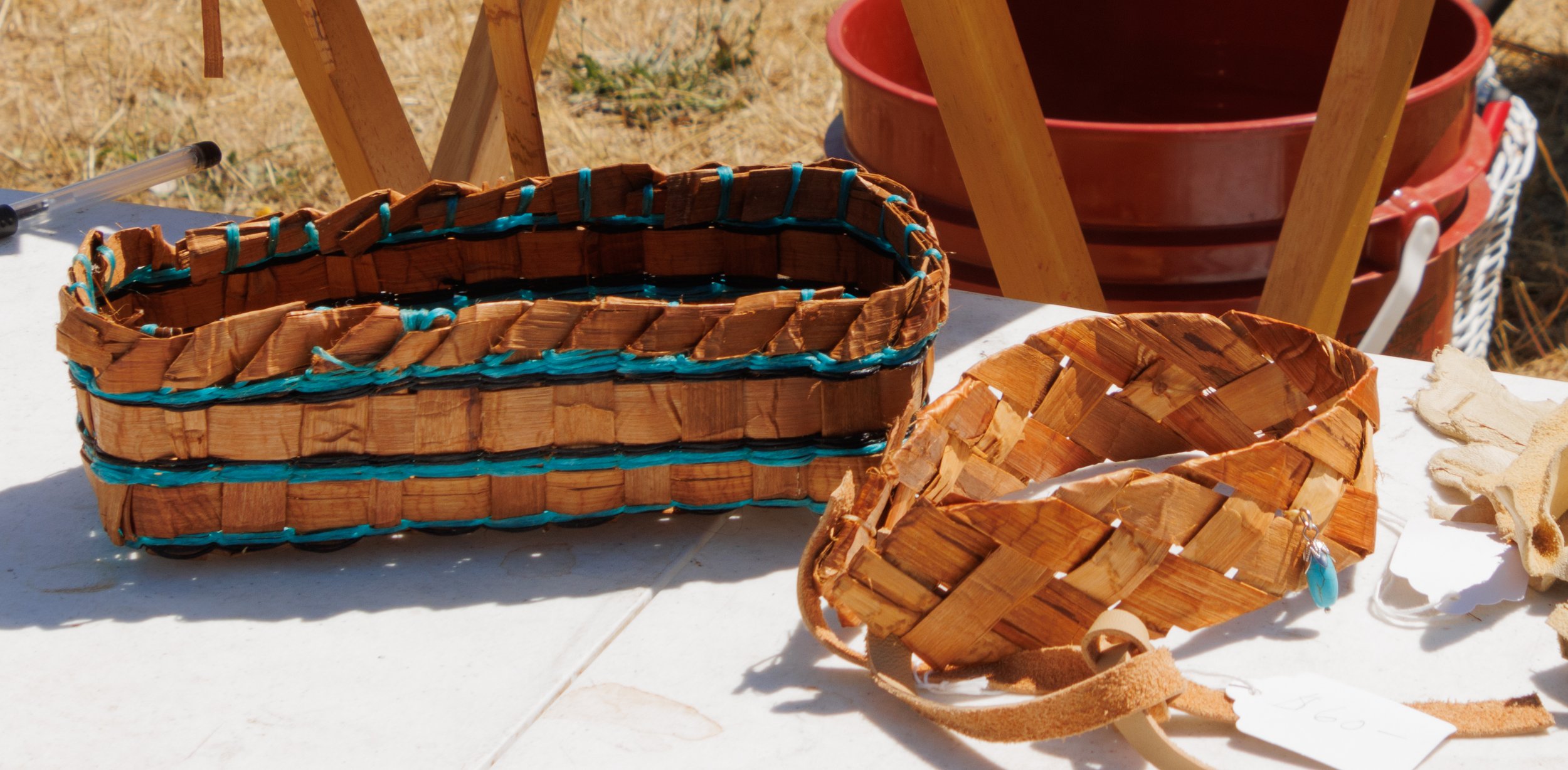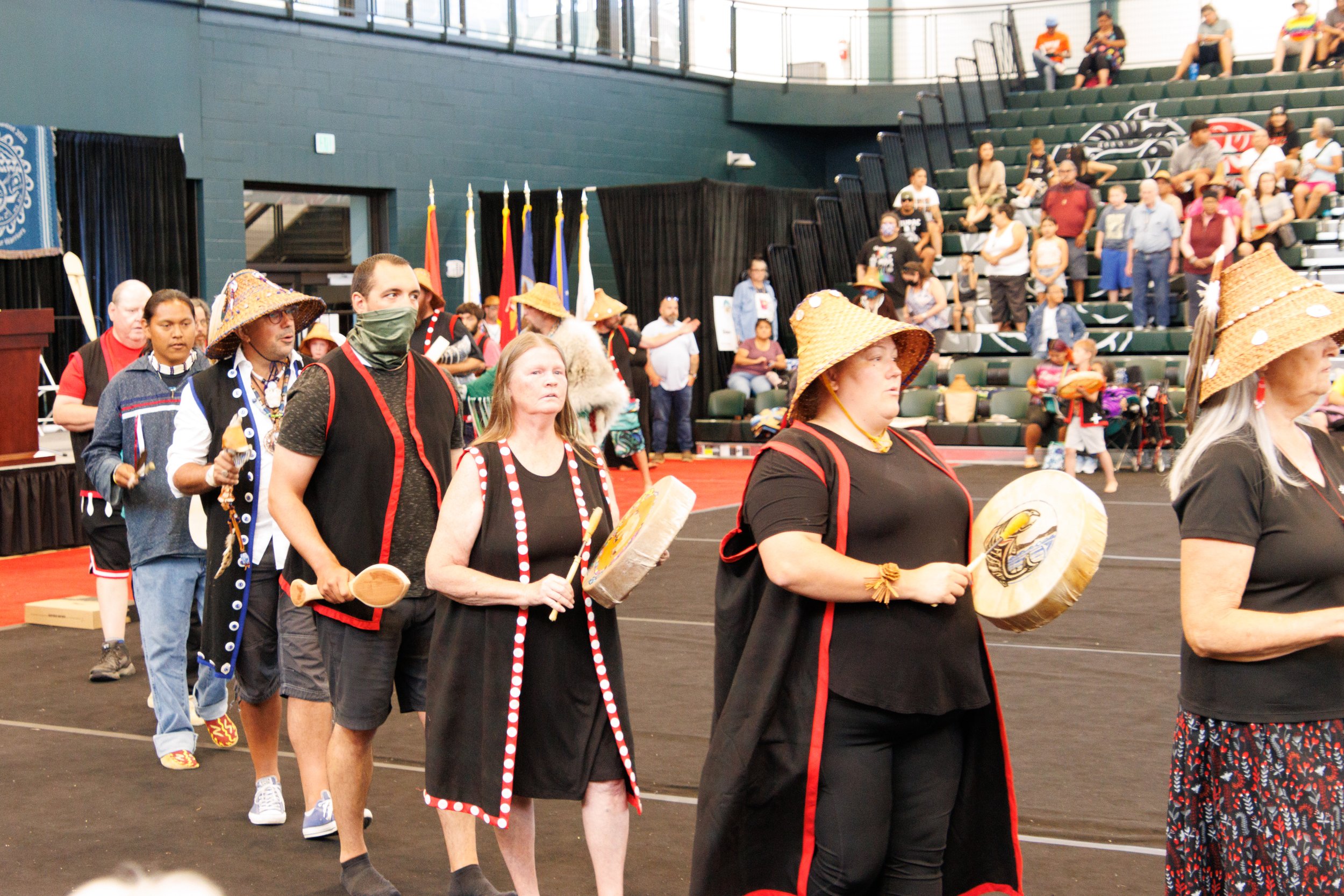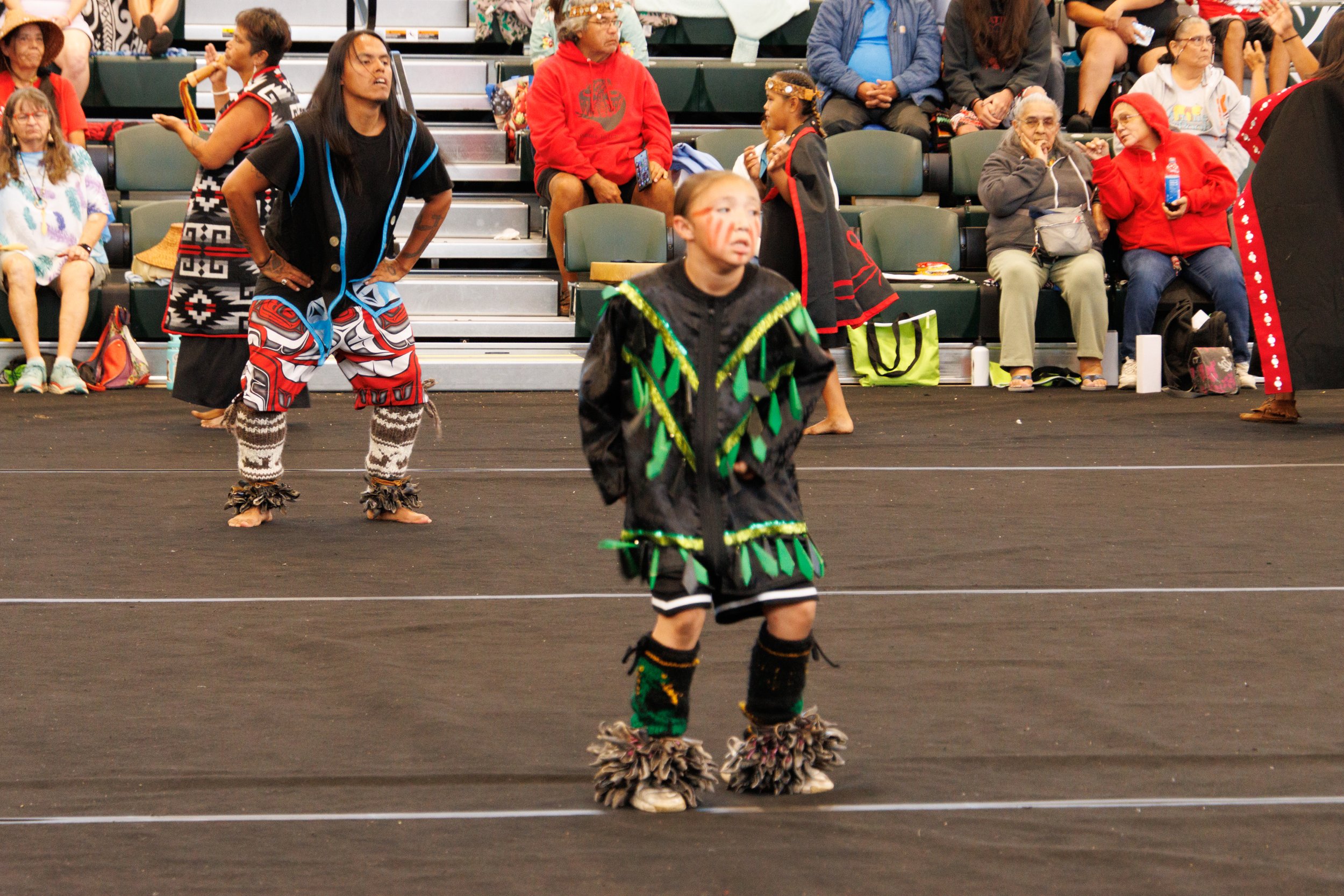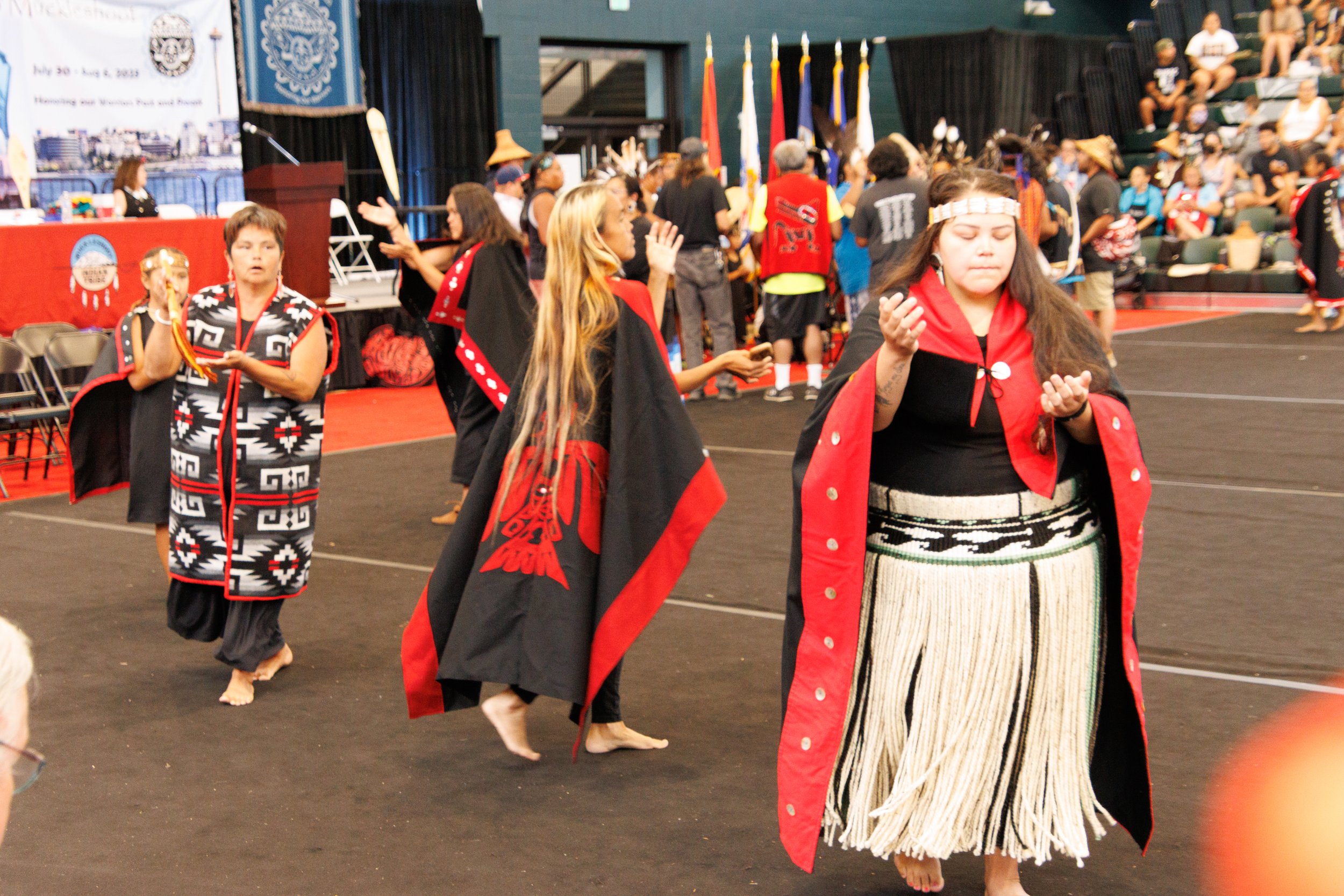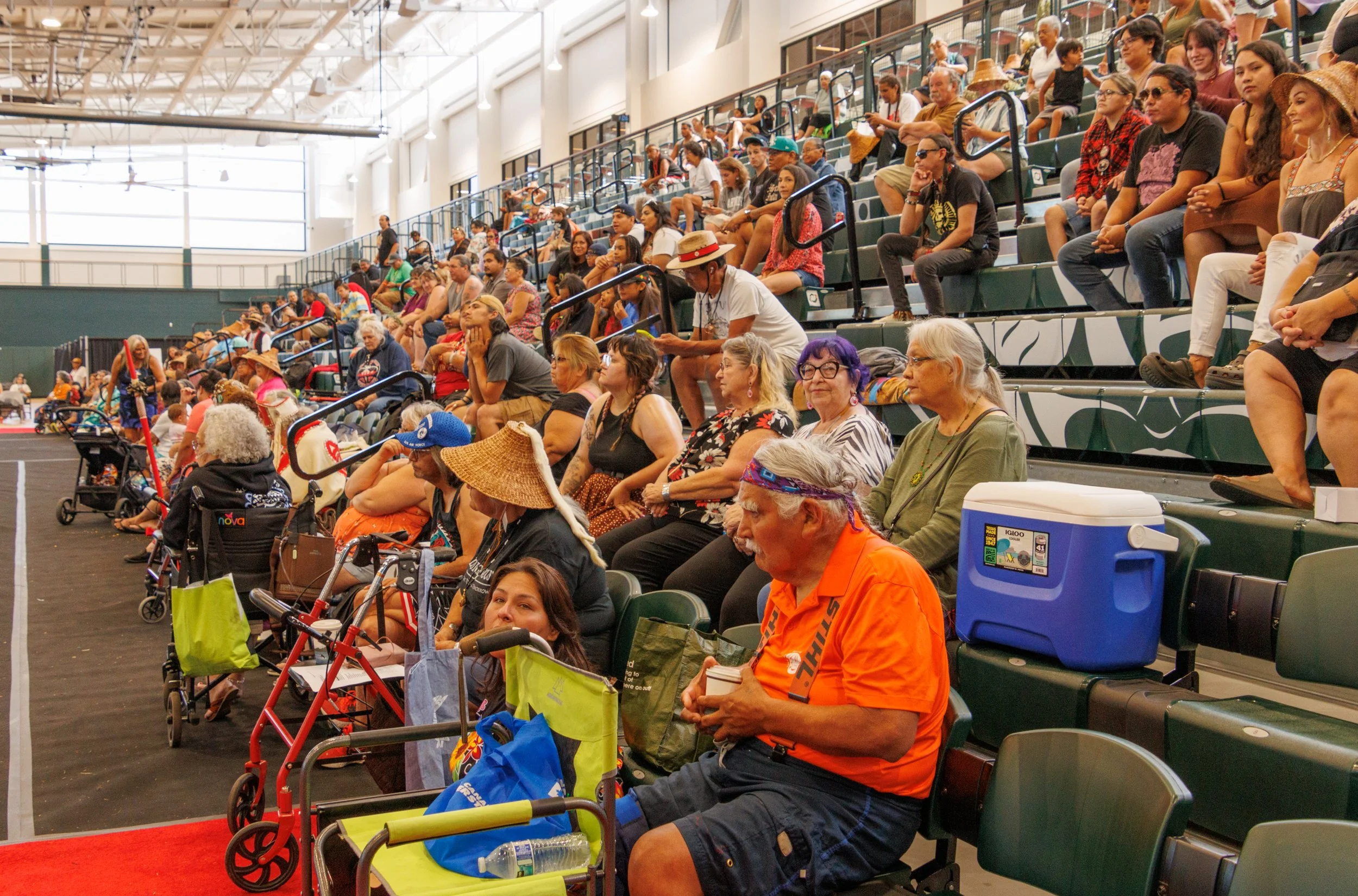Canoe Journey
On July 30th more than one hundred canoes landed at Seattle’s Alki Point, as the 2023 Canoe Journey kicked off. Once all the canoes were on shore, eight to ten thousand tribal members from around the Pacific Northwest gathered for dinner and celebration at the Muckleshoot tribe’s new Community Center in Auburn. Singing, dancing, stories and gifts were part of the weeklong celebration of culture and heritage through Sunday, August 6.
The first Journey, known as Paddle to Seattle, took place in 1989, not coincidentally the same year as the Washington State bicentennial. In the mid-1980’s, as planning for the state’s celebrations began, Emmett Oliver, the supervisor of Indian education at the time, saw an opportunity to include Native participation in bicentennial programming. Oliver thought about canoes and their significance and convinced then Governor Booth Gardner to commission the carving of eight canoes for the ceremony. At that time the art of canoe building was virtually lost, as many of the tribes hadn’t carved or built a canoe for over 50 years. On July 21, 1989, 40 canoes landed at Golden Gardens Park, followed by several days of celebration. The week following the landing included protocol and ceremonies to educate participants, especially youth, about Native Americans and their individual tribal traditions and culture, thus inspiring the annual Tribal Canoe Journeys.
Canoes had played an important role for the Coast Salish peoples for centuries. As the primary source of transportation between coastal communities, it was used for trade, fishing, hunting whales and seals, and cultural exchange. During the 19th and 20th centuries, Native access to their land, their practices, and their cultures were lost. Now indigenous youth are participating in their local canoe families and learning the value these journeys have on their culture. The Canoe Journey has grown to its current role “as part of a renaissance among indigenous peoples worldwide who are reclaiming their cultures”.
The host tribe for this year’s Canoe Journey was Muckleshoot, located in Auburn, Washington. Its theme was “Honoring Our Warriors Past and Present”. Participating tribes came from throughout the Pacific Northwest in both the U.S. and Canada. Each started from their home location on a date that would assure their arrival at Alki on July 30. The canoes were followed by motorized support boats carrying food, medical supplies, equipment, and provided a place for those in the canoe to rest. Other support crews drove in vans to set up camp and cook for the crews every night.
While Muckleshoot was the final destination this year, tribal rest stops were available along the way for the paddlers to rest and recharge during journeys that ranged up to hundreds of miles. These hosts provided sleeping/camping arrangements, food and comradery during the last week of travel.
Monday, July 24: Lower Elwha and Samish
Tuesday, July 25: Jamestown S’Klallam and Swinomish
Wednesday, July 26: Port Townsend and Cama
Thursday, July 27: Port Gamble S’Klallam and Tulalip
Friday, July 28 and Saturday, July 29: Suquamish
Canoes coming from farther away, for example, Quinault, Queets, Quileute and Hoh, started even earlier, on Friday, July 21 and arrived at Neah Bay after “pulling” for as long as twelve hours along the coast of the Olympic Peninsula. After some rest and nutrition, they navigated into the Strait of Juan de Fuca, passing between Cape Flattery and Tatoosh Island, the northwesternmost point of the contiguous United States. Many of the tribes came with multiple canoes – each one was paddled by a “canoe family” – the members of the crew.
I arrived at Alki Point about an hour before the first canoe landed. A crowd of predominantly Natives grew over that short time until thousands were sitting under umbrellas, walking on the beach and wading in the water, patiently waiting for the canoes to appear. Especially those with cameras, included me, competed for the best locations. As the canoes inched closer to land, the observers moved closer to and into the water toward the incoming canoes. Starting with just a few canoes making it to the shore, there were soon many joining the others as they paddled from Suquamish where they stayed the night before. And the waiting continued for hours.
Just because canoes had made it to Alki Point, that doesn’t mean they were able to come ashore. There is a pecking order. As more and more canoes arrived, the number of those waiting in order of their arrival, grew rapidly. When it was each canoe’s turn, it moved to a separate landing area, where a ceremony took place before they “entered”. The ceremony was a request from the visiting tribe to the host whose representative was located a distance away from the canoes, both using loud microphones to speak with each other and the waiting crowd. The words below are some of those used during the ceremony – first in each native language, then repeated in English.
Visiting tribe: “We are from the tribe of (tribal name). We come in peace. We are tired and hungry and wish to share songs and dances. We are raising our hands to the people of this land. We’re honored to be on your beaches, and we ask permission to come ashore”.
Host: “We welcome you to the homelands and waters of the Muckleshoot people. You have permission to come ashore”.
Once permission is given and the crew leaves their canoe, approximately two dozen event volunteers and observers gather around the approximately 1000-pound canoe, lift it above their heads, and carry it to its assigned places on the beach. Some tribes have multiple canoes, each having its tribe’s flag on it.
I found myself in the water, along with dozens of others. It didn’t matter that the water was to my knees and the seaweed was so thick I could hardly see my shoes when I was back on the sand. It was almost like being an “extra” in a story that was developing before my eyes, following a well-executed script. It was quite the experience.
I left Alki Point when about thirty canoes were sitting on the beach and an equal number were lined up in the water waiting to be recognized. Even more were still out in Puget Sound moving toward land. It seemed like I had been there for a long time, but there were still so many more canoes to arrive. Once they arrived, crews were taken by bus to the Muckleshoot Reservation where they could shower, rest, and freshen up before the first meal together that evening. Each canoe was transported almost forty miles to Auburn, where the remaining activities occurred over the next six days. Auburn does not have direct access to the waters, explaining the canoe arrivals at Alki Point.
I had traveled to Auburn several days later to see what was happening during the last days of Canoe Journey. The reservation was packed full of cars, campers, and concessions. Mount Rainier was revealing its beautiful, snow-covered peak in the background. With the mountain so close, I think the Muckleshoot people knew what they were doing when they selected this native location on which to settle. To stay outside a bit longer I walked around the vast number of tents with food or items, many handmade, for sale. Once I had my bean fry bread taco, I was ready to move inside to experience the real purpose of my visit to Auburn.
Protocol is the way visiting tribes give thanks to the host tribe by offering songs, dances, and stories, and concluding by exchanging gifts. The tribes then ask for permission to leave with their canoes. The host tribe is the last to appear, also with songs and dances and a final feast before the visitors return home. During the protocol each tribe is assigned a two-hour period of time during the week. The days often continue through the night so I was confident that I’d find plenty of activity when I arrived.
When I entered the Muckleshoot Community Center, the Chehalis Tribe was toward the end of their presentation. They finished some singing, then moved directly into tribal members offering gifts to some of the Muckleshoot people. They gave blankets by placing them on the recipients’ shoulders. Other gifts ranged from drums to handmake objects such as necklaces or baskets. In some cases, gifts were distributed among people sitting on bleachers as well. I was the lucky recipient of a beautiful hand-made glasses case and a Muckleshoot Tribe water bottle.
The next group was called Song Birds, representing one of the canoe families. I felt so fortunate to be able to sit on the bleachers with hundreds of tribal members from all over the region, and watch this joyous occasion. Men, women, and children participated, dancing in a large circle around the massive room or doing smaller dances individually in the middle.
Canoe Journey is one of the ways that cultural customs and values are passed down from generation to generation. Every culture has its unique way of assuring that their history and practices stay alive. It was meaningful for me to think about this concept in relation to my own culture and family history.




